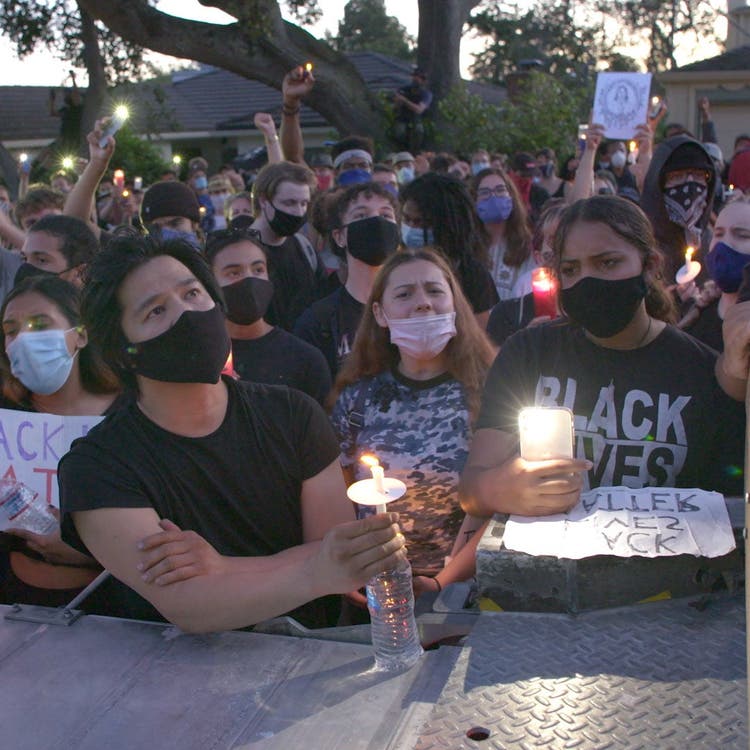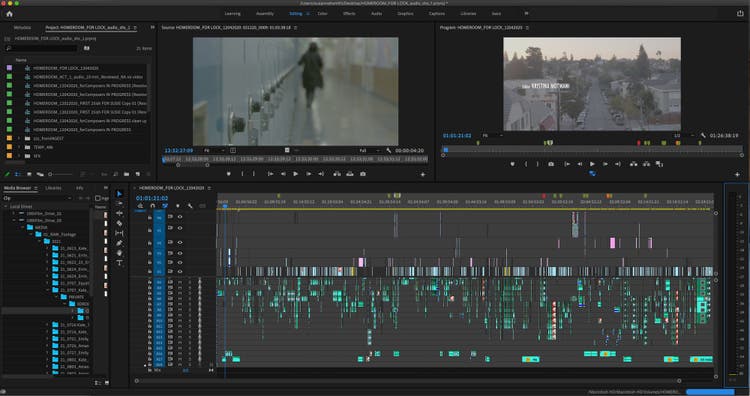Hulu’s Homeroom documents an unprecedented senior year

Image Source: Hulu.
Debuting at the Sundance Film Festival this year, Homeroom follows Oakland High School’s senior class of 2020 as they confront an unpredictable year. The filmmakers tell the inspiring story of the students while they navigate college applications and tests amidst the uncertainty of the COVID-19 pandemic. The end of their senior year takes a turn when the pandemic hits and soon gives way to the social justice movement across the country. In the wake of adversity, the Oakland High School seniors band together to help create change in their community.
We connected with the film’s co-writer and editor, Kristina Motwani, to learn why Premiere Pro, After Effects, and Photoshop were the right choice to bring the moving story to life. Kristina received the Documentary Film Editing Award at the 2021 Sundance Film Festival, honoring her work on the project.
How and where did you first learn to edit?
I was an art major in college. I had taken a video art class and began making very weird art videos. I realized I loved doing the editing and thought, “Hey, this could be an actual job!” The class was more theory-based than technical and they just kind of handed you the equipment and said make something. So, I was mostly self-taught on the technical side of editing.
How do you begin a project/set up your workspace?
Well, this is the moment, of course, that I give a shout out to my assistant editor, Susie Smith, who I usually task with setting up my projects and organizing the sheer amount of materials we usually have. Since I do vérité docs, we usually have a large shooting ratio, so therefore a ton of material. Susie usually begins by organizing everything on the backend, making proxies, and syncing. Then, she makes me a master project with each day of shooting strung out in its own sequence in one massive project. She also does logging in that project, using markers, and then we export those markers and can upload them into a spreadsheet for easy searching (you can also search on them in Premiere Pro, but we are often working with producers and directors who love the spreadsheet for finding what material we have).
Then, I usually pull sequences from that project into a new project just for cutting. As far as my workspace in Premiere Pro, I have a custom I have dialed in over the years and that is one thing I love about Premiere Pro because Susie and I are often working on the same projects. She has her own custom setup she likes as well and it is easy to switch from her setup to mine in about two seconds.
Tell us about a favorite scene or moment from this project and why it stands out to you.
I have to call out two scenes, one being one of the hardest to cut in the film and one is the easiest. The first, one of the hardest, was the COVID-19 “stay at home” montage moving into the social uprising as a response to George Floyd’s murder. We had always known we wanted to use social media to convey how the young people in the film see the world, but it was a tough nut to crack to make that feel immersive enough to feel real. I think after many iterations of how to cut all that social media material together we ended up with something quite visceral. The second scene, the easiest, was the graduation scene. I originally cut it as just Edgar performing his poetry for his family, but we started to get material from the other young people in the film having their at-home graduations and it made sense to cut to them. We showed them having a collective experience, but apart. Once I did that, the scene remained largely unchanged from its almost first cut, and I remember I teared up watching it.
Image Source: Kristina Motwani.
What were some specific post-production challenges you faced that were unique to your project? How did you go about solving them?
I’d say the sheer volume we had of material. We had a lot of vérité shot in the school before coronavirus as well as an incredible amount of social media and archival we had pulled from everywhere. The challenge was really keeping that stuff organized and up to date. I had begun cutting in April, which was when we first got stay-at-home orders in San Francisco. We stopped shooting for a few months out of safety, of course, but during that time the team was really working on gathering social media, zoom interviews with the young people, and archival. Then we were able to shoot again, which meant we were still getting a large influx of media. We knew this was a timely story and it had changed so drastically since I started working on the project that the other challenge was getting it out in the world quickly.
So, we brought on another editor, Rebecca Adorno, before we submitted to Sundance. He was wonderful and brought some much-needed fresh eyes at that point to the project. Getting over the finish line was a true group effort on this film, from Pete (director/producer), Sean (DP/producer), Gaby (associate producer), Rebecca (editor), Susie (assistant editor), Maya (production assistant) and our wonderful post supervisor, Alex Exline. For the last few months of post, this project was literally all hands on deck and all remote. I never had another person in the room with me as I was cutting this film.
What Adobe tools did you use on this project and why did you originally choose them? Why were they the best choice for this project?
We used Premiere Pro for the editing. We chose it because it is always my go-to for editing. I have been using it for so long it just feels like an extension of my body at this point! Also, everyone on the crew had some level of familiarity with it which was very helpful for those times when it was all hands-on deck. We also used Adobe After Effects for the social media in the film.
What do you like about Premiere Pro?
When I first started editing, I was using a different solution, then I made the switch to Premiere Pro. The transition was much easier than I anticipated. I feel like a lot of the functions are pretty intuitive and so it’s just easy for me to use.

Image Source: Kristina Motwani.
What’s your hidden gem/favorite workflow hack in Adobe Creative Cloud?
I’m sure everyone says this, but keyboard shortcuts. I have made mine fully custom and used that custom template for a long time. I love that I can just take that little keyboard file with me to any machine I work on and I have my little time-saving shortcuts wherever I go.
Who is your creative inspiration and why?
Oh gosh, so many people! I’d say maybe the first one is Jonathan Caouette, who made the autobiographical doc Tarnation. I remember I rented that film from Blockbuster, back when you had to actually get the physical media. I watched it in my college apartment and I thought, “Wait a minute. This dude, with basically no editing experience, edited this film in iMovie and it is so engaging, developed, and moving.” It made me feel like what matters most isn’t your technical prowess, but your storytelling skills, and I loved that!
These are just tools to help you reach your goal, not something to be afraid of. It was what inspired me to go after being an editor. A couple of other honorable mentions. I’d say Emelie Mahdavian, who I worked with on Midnight Traveler. She is a genius and I learned so much creatively from working with her. Sean Havey is an incredible creative partner to work with. Finally, N’jeri Eaton, who is one of my closest friends, but often also my sounding board and always brings new, creative thoughts to my mind when I pick her brain.
What’s the toughest thing you’ve had to face in your career and how did you overcome it? What advice do you have for aspiring filmmakers or content creators?
Getting opportunities as a female editor. I think there is still a lot of sexism in our industry, and a lot of it especially in the jobs that require quite a bit of technical prowess. I think it’s getting better, but we have some ways to go. I don’t know if I’ve totally overcome it, but I think knowing what I bring to a project and being able to convey that to people has helped. My biggest advice for aspiring filmmakers is that this is a long game with a lot of obstacles and sometimes rejection. Just keep pushing and believe in yourself and your project. It will pay off.
Image Source: Kristina Motwani.
What’s your favorite thing about your workspace and why?
My cats! My workspace for the last year and a half during COVID has been my one-bedroom apartment in the middle of San Francisco, which, while not ideal, I’ve learned to make it work. For me, the thing that has kept me from going insane working in my space is being mobile. I work with a laptop and have different stations around my apartment so I can change up where I work. I just connect to my drives, which I keep on a rolling cart, a monitor, and a keyboard/mouse. I can work kind of anywhere, nothing stops the edit!
Image Source: Hulu.
Homeroom is currently streaming on Hulu.